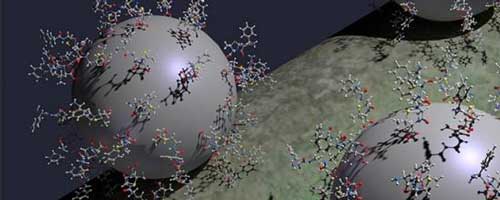Nanocoatings
The term nanocoating refers to nanoscale (i.e. with a thickness of a few tens to a few hundreds of nanometers) thin-films that are applied to surfaces in order create or improve a material's functionalities such as corrosion protection, water and ice protection, friction reduction, antifouling and antibacterial properties, self-cleaning, heat and radiation resistance, and thermal management.
Nanocoatings offer significant benefits for applications in the aerospace, defense, medical, marine, and oil industries, have driven manufacturers to incorporate multi-functional coatings in their products.
Self-cleaning, dirt and water repellent nanocoatings
A surface is not simply the physical division between an object and its environment; it fulfils a range of functions of its own which often play a crucial part in product design. Surfaces are supposed to feel good to the touch and to look good for as long as possible, be easy to maintain and not be spoiled by dirt, water stains or fingermarks.
Traditional coating materials often do not stand the test of the increased demands made on materials today. In recent years however, advances have been made using methods ascribed to nanotechnology.
Our article "Nanotechnology solutions for self-cleaning, dirt and water-repellent coatings" gives a short overview of the basis of these structures, the processes involved in their manufacture, the areas where they can be used, and the effect they have on the environment and human health.
Nanocoatings also have been developed to protect buildings against pollution or to impregnate fabrics to thwart certain chemical weapons.
Antibacterial nanocoatings
Developing strategies to combat antibiotic-resistant bacteria is a major application area for nanocoatings. For instance, researchers have coated nanoparticles with a layer of antibiotics. Owing to chemical affinity, the resulting nanopharmaceutical acts only on the pathogens and is inert to the organism.

In another proof-of-concept study with mice, scientists have shown that a novel coating they made with antibiotic-releasing nanofibers has the potential to better prevent at least some serious bacterial infections related to total joint replacement surgery.
Researchers also have shown that anti-adhesive nanofilm patches that are developed from naturally occurring biomaterials can prevent destructive bacterial biofilm from forming on metal surfaces when they are immersed in water and other damp environments.
Anti-corrosion applications
Given the huge economic incentives, corrosion prevention and protection is a major business. The advanced materials that are being developed and used in modern industries require increasingly sophisticated coatings for improved performance and durability. Some research features graphene as a promising novel surface coating that can be used to minimize metallic corrosion under harsh microbial conditions.
Other scientists have developed self-healing anticorrosion nanocoatings as alternative to toxic chromium.
Another novel active protective nanocoating is able to indicate when corrosion processes start under the coatings or in different defects; it thus acts as a sensor.
Anti-friction and tribology applications
What happens when a fluid is brought in contact with a solid surface – the process of 'wetting' – has intrigued physicists and material engineers for a long time. In physical terms, the process of wetting is driven by the minimum free energy principle – the liquid tends to wet the solid because this decreases the free energy of the system. Understanding these mechanics, and using nanotechnology to structure surfaces to control wetting, has a far-reaching impact for many objects and applications in our daily lives: anti-sticking pans; low-friction coatings for engine parts; more comfortable contact lenses; better prosthetics; and self-cleaning, anti-fouling or anti-corrosion materials.
Tribologists – scientists who study friction, wear, and lubrication – are using graphene and other carbon nanomaterials to fabricate low-friction surfaces.
Historically, the use of Teflon (the anti-stick coating you find in many pans and pots) in bearings has been limited due to a poor wear life and low adhesion to bearing components. Novel thin, low-friction nanoparticle coating eliminates these weaknesses.
A major area for non-stick nanocoatings is in the comsumer industry. Ever got frustrated by the amount of ketchup left in the bottle? No more! Nanocoatings leave no waste behind:
Other high-tech nanocoating applications
Experimental physicists have developed a nanocoating with superconducting properties. Below about -200°C these materials conduct electricity without loss, levitate magnets and can screen magnetic fields. The particularly interesting aspect of this work is that the research team has succeeded in creating superconducting nanowires that can be woven into an ultra-thin film that is as flexible as cling film. As a result, novel coatings for applications ranging from aerospace to medical technology are becoming possible.
A nanocoating made from carbon nanotubes that, when layered around an aluminum-conductor composite core power transmission line, reduces the line's operating temperature and significantly improves its overall transmission efficiency.
A novel nanocoating for aircraft engines may triple service life and reduce fuel consumption.
In order to extend the life of fruits and vegetables and preserve them for longer refrigeration, researchers developed an edible nanocoating with added functional ingredients applied to freshly cut foods.
